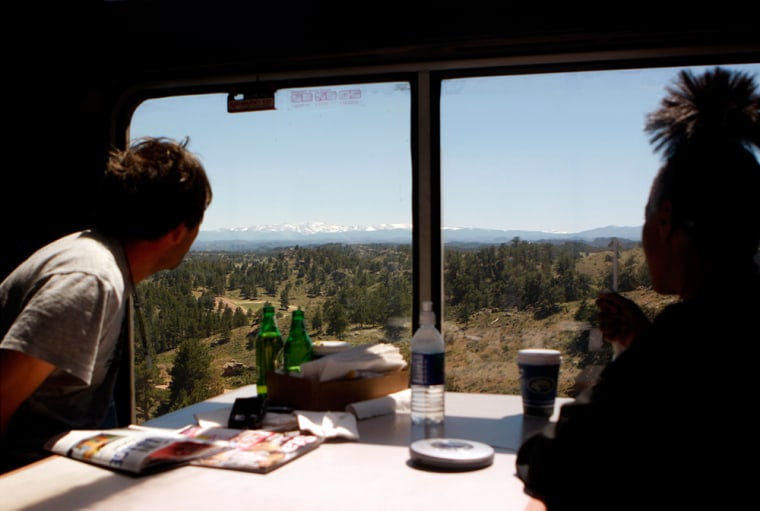If you’ve ever ridden a train and wondered what was rolling by your window, Amtrak and the National Park Service (NPS) may be able to help. This summer, on-board volunteers are riding the rails, pointing out local landmarks and putting the countryside in context from Upstate New York to Southern California.
It’s all part of the Trails & Rails program, a joint program between the Park Service and Amtrak that operates on 12 trains across the country. Now in its ninth year, it’s designed to showcase the cultural and natural heritage of each local area.
“Riding the train without the guides is like watching the Travel Channel with the sound off,” says NPS Programs Coordinator Jim Miculka. “If you turn on the volume, you can learn what that mountain or river or historic site is.”
For a full accounting of the trains, parks and itineraries involved, visit the Trails & Rails page at NPS.gov. In the meantime, the following five itineraries will put you on the right track:
Adirondack
Bookended by New York and Montreal, the Adirondack spends much of its route traversing the less-crowded countryside of the Hudson River Valley and eastern Adirondacks. Along the way, riders can experience, not one, but two Trails & Rails programs.
For an easy morning outing, consider tagging along from Croton-Harmon to Hudson, an 80-minute run narrated by volunteers from the Vanderbilt Mansion National Historic Site. Hugging the east bank of the Hudson, the train passes several historic sites, including Bannerman’s Castle, the U.S. Military Academy at West Point (across the river) and Frederick Vanderbilt’s 54-room summer home.
If time allows, continue north to Albany where volunteers from Saratoga National Historical Park get on board for the five-hour run to the Canadian border. With Lake Champlain on one side and the Adirondacks on the other, the commentary can help you avoid swivel-neck syndrome.
Crescent
Strictly speaking, there are no NPS units along the Crescent’s 12-hour route between Atlanta and New Orleans. Even so, the two cities’ contributions to the nation’s cultural heritage make the trip a worthwhile endeavor.
To get the most out of it, start a day early in Atlanta and visit the Martin Luther King, Jr. National Historic Site, where a 70-artist exhibition dedicated to Dr. King runs through July 19. Once on board, settle in as volunteers from the site guide you through the forests, swamplands and antebellum towns of Alabama and Mississippi. After a good night’s sleep in New Orleans, visit the New Orleans Jazz Historical Park or Jean Lafitte National Historical Park and Preserve.
Sunset Limited
West of San Antonio, the Sunset Limited heads for the arid expanse of West Texas. First, though, it stops in Del Rio, on the Mexican border, where volunteers from the Amistad National Recreation Area get on board for the five-hour ride to Alpine, near Big Bend National Park.
Outside Del Rio, the train crosses Amistad Reservoir, a man-made lake set at the confluence of the Rio Grande, Pecos and Devils rivers. After that, things get very dry very fast, with miles of desert separating small towns such as Langtry (of “Judge” Roy Bean fame) and Sanderson (aka, the Cactus Capital of Texas). If you get off in Alpine, you can rent a car for the 80-mile drive to Big Bend National Park; if not, it’s another four hours to El Paso.
Southwest Chief
One of the nice things about having on-board guides is that they can alert you to upcoming photo ops. That’s especially handy on the Southwest Chief, where volunteers from Bent’s Old Fort National Historic Site point out the highlights along the train’s scenic, 7.5-hour run from La Junta, Colo., to Albuquerque, N.M.
The route, which follows a major branch of the Santa Fe Trail, hits its highest point (7,588 feet) at Raton Pass on the Colorado-New Mexico border. From there, vistas of mesas and mountains are interspersed with stories of Indians, outlaws and pioneers. The train skirts Pecos National Historical Park (archeological ruins), traverses Apache Canyon (site of a major Civil War battle) and rolls into Albuquerque in time for happy hour or an early dinner.
Empire Builder
Given its route — 2,200 miles from Chicago to Seattle — it’s hardly surprising that the Empire Builder supports multiple Trails & Rails programs. Four, in fact, each of which offers its own scenic take on the history of western expansion.
Depending on your itinerary, you’ll find yourself following the Mississippi River (think paddlewheelers and grain barges), crossing the northern plains (think Lewis and Clark) or traversing “the crown of the continent” (along the southern edge of Glacier National Park). This year, the program between Minot, N.D., and Shelby, Mont., will also feature artisans provided by the North Dakota Arts Council and special performances by Keith Bear, a Mandan/Hidatsa storyteller and flute player.
Think of it as the soundtrack for the scenery outside your window.
Rob Lovitt is a frequent contributor to msnbc.com. If you'd like to respond to one of his columns or suggest a story idea, .
